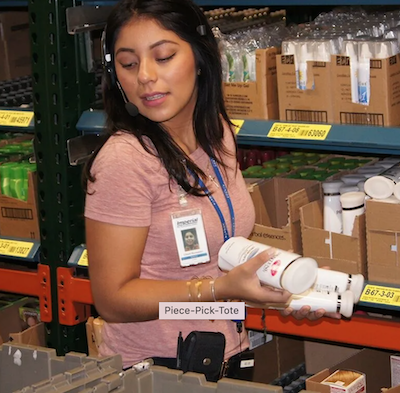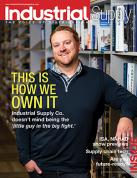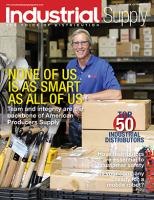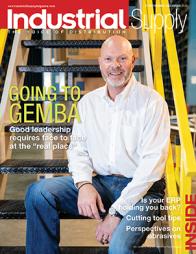The intuitive warehouse – how voice technology accelerates picking
By Ron May
In his bestselling book, "Thinking, Fast and Slow," Daniel Kahneman, explains the two systems that drive the way human beings think. System 1 is fast, intuitive, and emotional; System 2 is slower, more deliberative, and more logical.
 Human senses play a crucial role in System 1 thinking because this mode of thought relies heavily on immediate perception, intuition, and pattern recognition. Some senses, like sight and hearing, are particularly effective at driving System 1 responses due to their speed and ability to process large amounts of information effortlessly. This makes it ideal for tasks that require quick decision-making and minimal cognitive effort, like warehouse picking operations. Voice-directed picking aligns closely with System 1 principles and processing, giving it significant benefits and advantages over other types of picking methods in a warehouse setting. Here’s how:
Human senses play a crucial role in System 1 thinking because this mode of thought relies heavily on immediate perception, intuition, and pattern recognition. Some senses, like sight and hearing, are particularly effective at driving System 1 responses due to their speed and ability to process large amounts of information effortlessly. This makes it ideal for tasks that require quick decision-making and minimal cognitive effort, like warehouse picking operations. Voice-directed picking aligns closely with System 1 principles and processing, giving it significant benefits and advantages over other types of picking methods in a warehouse setting. Here’s how:
Faster decision-making and execution – System 1 is designed for rapid, intuitive responses, and voice-directed picking enhances this by allowing workers to process information through hearing, one of the fastest sensory inputs. With voice-directed picking, workers receive instructions in real time, eliminating the need to stop and read a screen or paper, which streamlines the picking process and reduces delays. In contrast, RF scanners or paper-based picking require visual focus, slowing decision-making as workers must shift their attention between instructions and the items they are picking. For example, a worker wearing a voice headset can hear, “Go to location B4, pick five cases,” and instinctively move to complete the task without pausing to check a screen.
Hands-free, eyes-free operation boosts efficiency – Voice-directed picking allows workers to keep their hands and eyes free, significantly reducing cognitive load and increasing overall productivity. By relying on auditory instructions rather than visual cues, workers can remain fully engaged in handling products and navigating the warehouse without unnecessary distractions. In contrast, RF scanners and pick-to-light systems require continuous visual engagement, forcing workers to interrupt their tasks to scan, read, and confirm information before continuing.
These interruptions break the natural flow of movement and can slow down operations, especially in high-paced environments. The uninterrupted process of voice-direction not only increases speed but also helps reduce mental fatigue, as workers can rely on intuitive voice prompts rather than constantly shifting their attention between different inputs. Depending on your process (e.g., full case picking from pallets vs. piece picking from flow racks), productivity gains may range from 10-90% with voice optimization.
Reduced cognitive load and fatigue – System 1 relies on intuitive processing, allowing individuals to respond quickly and effortlessly while reducing mental strain. Rather than requiring workers to interpret complex visual data, voice systems provide natural spoken commands, guiding them through the process without the need for conscious effort. This eliminates the cognitive burden associated with reading, memorizing, and recalling multiple pieces of information at once.
With a voice-directed system, a worker doesn’t need to read and retain detailed location and quantity information, such as “Aisle 12, Section B, Shelf 4, Pick 7.” Instead, they can simply listen and respond, allowing for a smoother, more efficient workflow that aligns with the brain’s natural ability to process and act on auditory cues.
Faster error detection and correction – System 1, while fast and intuitive, can also be prone to bias and errors, as quick decisions are sometimes made without thorough verification. However, voice-directed picking mitigates this risk by incorporating built-in error checks through verbal confirmation, creating a continuous feedback loop that enhances accuracy. Instead of relying solely on visual verification, workers verbally confirm key details such as quantity and location codes, ensuring real-time validation before proceeding. This process significantly reduces the likelihood of mistakes, as errors can be caught and corrected immediately.
With a voice-directed system, the worker must audibly confirm their action, which not only reinforces accuracy but also ensures that any discrepancies are immediately identified and addressed. A voice-directed optimization solution helped Apex Tool Group a leading global manufacturer of professional hand and power tools, reduce errors by 63%.
Improved situational awareness and safety – Hearing functions in a 360-degree range and does not require visual focus, making it an essential advantage in environments where situational awareness is critical. In a warehouse setting, voice-directed picking allows workers to receive and process instructions while keeping their eyes on their surroundings, enhancing both safety and efficiency. The majority use one-ear headsets, leaving the other ear open so they can still have unobstructed ability to hear any alerts or challenges. This heightened awareness is particularly valuable in fast-paced operations where distractions can lead to serious accidents.
For example, a worker using a handheld scanner may become absorbed in aligning a barcode or verifying information on a screen, failing to notice a forklift reversing nearby. By minimizing visual distractions and keeping workers engaged with their environment, voice-directed picking not only improves efficiency but also plays a crucial role in maintaining a safer workplace.
Faster onboarding and training – System 1 as explained in Kahneman’s book, facilitates learning through pattern recognition and repetition, making it ideal for environments where quick, intuitive decision-making is essential. Voice-directed picking leverages these principles to enable fast, effective training for new hires. Workers receive clear, step-by-step voice instructions, allowing them to learn the process as they perform the tasks, without the need for lengthy or complex training.
This hands-on, auditory approach helps them build familiarity and confidence quickly, reducing the cognitive load typically associated with learning a new role. A new picker equipped with a headset can start picking within minutes by simply following spoken instructions, such as “Go to aisle 3, pick 4 items from shelf 2,” rather than needing to memorize a series of complex steps or data. This not only reduces the learning curve but also accelerates the overall productivity of new team members, allowing them to contribute efficiently to the workflow in a short period of time.
Global healthcare distributor Henry Schein realized a 20%–30% reduction in training time after implementing a voice optimization solution. Many voice systems also provide the ability to automatically shift into more efficient dialogs as the user learns (e.g. ‘Smart Dialogs’ where prompts for pick location/quantity/put location can be used and advanced users can respond to one, two or all three prompts in one utterance.)
Voice-directed picking harnesses the strengths of System 1 by leveraging fast, intuitive responses through auditory instructions, allowing warehouse workers to perform tasks with minimal cognitive load and greater efficiency.
By aligning with the brain’s natural ability to process information quickly and effortlessly through hearing, voice-directed systems improve decision-making speed, reduce errors, and enhance situational awareness. This results in a safer, more productive environment, particularly in high-paced operations where rapid action is essential.
Ultimately, by integrating System 1 principles into warehouse operations, voice-directed picking optimizes both human performance and operational efficiency.

Ron May is a founding member and senior solution consultant at Lucas Systems. A global expert on warehouse process optimization, voice-directed mobile applications, and user experience, he has nearly four decades of system design, development, and implementation experience. As its chief architect and software engineer, May developed Lucas software solutions, including its innovative voice-directed mobile applications.












